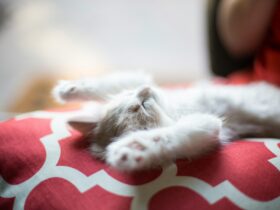Blog: How to Reduce Cat Dander & Allergies | What to Do if Your Cat’s Not Eating & How to Get Her Appetite Back
Introduction
Cats are known for their finicky eating habits, but when a cat suddenly stops eating, it can be a cause for concern. Loss of appetite, or anorexia, in cats can lead to serious health issues, including the exacerbation of dander production, which can aggravate allergies. Understanding the reasons behind your cat’s lack of appetite and knowing how to encourage her to eat again is crucial for maintaining her health and managing allergens in your home. This blog will cover the possible reasons why your cat might not be eating, how to stimulate her appetite, and the connection between diet and dander production.
Why Is My Cat Not Eating?
1. Medical Issues
- Dental Problems: Cats with dental issues, such as tooth decay, gum disease, or oral infections, may experience pain while eating, leading them to avoid food. Regular dental check-ups are essential to prevent and treat these conditions.
- Gastrointestinal Disorders: Conditions like inflammatory bowel disease (IBD), pancreatitis, or constipation can cause discomfort and lead to a loss of appetite. If your cat has ongoing digestive issues, it’s important to consult a veterinarian.
- Kidney Disease: Chronic kidney disease is common in older cats and can cause nausea, leading to a reduced appetite. Monitoring your cat’s kidney function with regular vet visits can help manage this condition.
- Respiratory Infections: Cats with upper respiratory infections may have a reduced sense of smell, making food less appealing. Ensuring that your cat’s nasal passages are clear can help her regain interest in food.
2. Psychological Factors
- Stress and Anxiety: Changes in your cat’s environment, such as moving to a new home, the introduction of a new pet, or changes in routine, can cause stress and anxiety, leading to a loss of appetite.
- Depression: Cats can experience depression, often due to the loss of a companion, boredom, or lack of stimulation. Providing enrichment and spending more time with your cat can help alleviate these feelings.
3. Changes in Diet
- Food Preferences: Cats can be very particular about their food. A sudden change in the brand or type of food can result in refusal to eat. Gradually transitioning to a new food can help avoid this issue.
- Food Aversion: If your cat associates a particular food with a negative experience, such as feeling sick after eating it, she may develop an aversion to that food.
4. Aging and Appetite
- Reduced Metabolism: As cats age, their metabolism slows down, which can lead to a reduced appetite. Older cats may need smaller, more frequent meals to maintain their weight and health.
- Sense of Smell: A cat’s sense of smell diminishes with age, making food less enticing. Offering aromatic foods or warming up her meals can help stimulate her appetite.
How to Encourage Your Cat to Eat Again
1. Rule Out Medical Issues
- Veterinary Consultation: If your cat has stopped eating, the first step is to consult your veterinarian to rule out any underlying medical conditions. Early diagnosis and treatment can prevent serious health problems.
2. Make Food More Appealing
- Warm Up the Food: Warming up your cat’s food can enhance its aroma, making it more appealing. A slight increase in temperature can make the food more appetizing, especially for cats with diminished senses of smell.
- Offer Strong-Smelling Foods: Foods like canned tuna, sardines, or cooked chicken can tempt a cat with a reduced appetite. However, these should only be used as a temporary measure or a treat.
- Try Different Textures: Some cats prefer wet food over dry food, or vice versa. Experimenting with different textures can help you find what your cat prefers.
3. Create a Calm Feeding Environment
- Reduce Stress: Ensure your cat’s feeding area is quiet and free from distractions. Reducing stress in her environment can help her feel more comfortable and more likely to eat.
- Separate Feeding Areas: If you have multiple pets, feeding your cat in a separate area can prevent food competition and stress, encouraging her to eat.
4. Use Appetite Stimulants
- Veterinary-Approved Stimulants: In some cases, your veterinarian may prescribe appetite stimulants to help your cat regain her desire to eat. These should only be used under veterinary supervision.
- Herbal Remedies: Some herbal remedies, like catnip or valerian root, can stimulate appetite in cats. Consult your vet before trying any herbal supplements.
The Connection Between Appetite, Diet, and Dander
1. Impact of Nutrition on Skin and Coat Health
- Balanced Diet: A well-balanced diet is essential for maintaining healthy skin and a shiny coat, which can reduce dander production. If your cat is not eating properly, her skin may become dry and flaky, leading to an increase in dander.
- Hydration: Proper hydration is crucial for skin health. Cats that eat wet food or drink plenty of water are less likely to have dry skin, which contributes to dander. If your cat is not eating, ensure she is drinking enough water to stay hydrated.
2. Allergies and Diet
- Food Allergies: Some cats may have food allergies that affect their skin, leading to increased dander. Identifying and eliminating allergens from your cat’s diet can improve her skin condition and reduce dander.
- Omega-3 and Omega-6 Fatty Acids: These essential fatty acids play a significant role in skin health. If your cat’s diet lacks these nutrients, her skin may become dry and flaky. Supplementing her diet with these fatty acids can improve her skin and coat condition, reducing dander.
3. Managing Dander Through Diet
- High-Quality Protein: Feeding your cat high-quality protein supports healthy skin and fur, reducing the likelihood of dander. Ensure her diet includes meat-based proteins, which are essential for her overall health.
- Supplements: In addition to a balanced diet, supplements like fish oil can help reduce dander. Consult your veterinarian before adding any supplements to your cat’s diet.
When to Seek Professional Help
1. Persistent Loss of Appetite
- Veterinary Consultation: If your cat’s appetite does not return within 24-48 hours, or if she shows other signs of illness, it’s important to consult your veterinarian immediately. Early intervention can prevent serious health complications.
2. Weight Loss and Dehydration
- Monitoring Weight: Regularly monitor your cat’s weight to ensure she is maintaining a healthy body condition. Rapid weight loss can be a sign of a serious underlying issue.
- Hydration: Ensure your cat stays hydrated, especially if she is not eating. Dehydration can exacerbate health problems and should be addressed promptly.
Conclusion
A cat’s loss of appetite can be concerning, but understanding the potential causes and knowing how to encourage her to eat again is crucial for her health and well-being. By addressing any underlying medical issues, making food more appealing, and creating a stress-free feeding environment, you can help your cat regain her appetite. Additionally, maintaining a balanced diet is essential for reducing dander production, which can help manage allergies in your home. Always consult your veterinarian if you notice any significant changes in your cat’s eating habits or overall health.











Leave a Reply